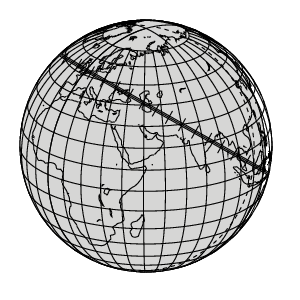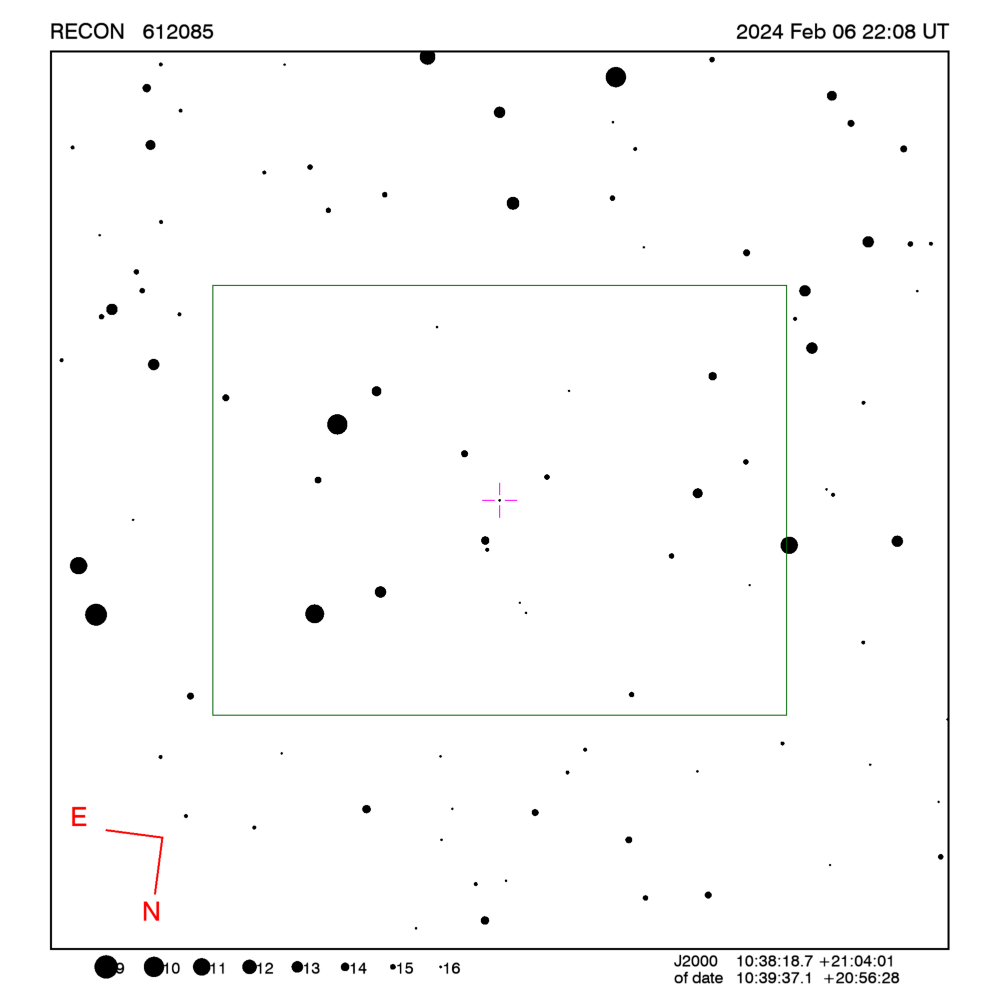RECON: TNO occultation with 612085
Event between (612085) 99CL119 and star GA1100:03451256
with event index number of 2805616
Geocentric closest approach at 2024/02/06 22:07:41 UTC
J2000 position of star is 10:38:18.7 +21:04:01
Equinox of date position of star is 10:39:31.4 +20:57:02
Stellar brightness G=16.7,
use SENSEUP=128 with the MallinCam and and exposure
time of 2 seconds with the QHY174 camera.
Star is 123 degrees from the moon.
Moon is 13% illuminated.
TNO apparent brightness V=22.8
 TNO is 46.6 AU from the Sun
and 45.7 AU from the Earth.
TNO is 46.6 AU from the Sun
and 45.7 AU from the Earth.
The TNO is moving 25.1
km/sec on the sky relative to the star, or,
2.7 arcsec/hr.
The 1-sigma error in the time of the event is 188 seconds.
The 1-sigma cross-track error in the shadow position is
3231 km.
The TNO has an absolute magnitude Hv=6.1
Diameter=359.8 km assuming a 5% albedo -- 14.3 sec chord
Diameter=146.9 km assuming a 30% albedo -- 5.9 sec chord
Dynamical classification is SCATEXTD
Star training set for 612085, (2024/02/06 22:08UT)
Object RA Dec mag sep mel
Regulus 10:09:39.2 +11:50:55 1.3 11.58 126
68Del Leo 11:15:23.2 +20:23:29 2.6 8.38 115
PPM 127658 10:45:32.2 +19:37:55 6.2 1.91 121
PPM 100484 10:36:35.8 +21:15:11 8.2 0.77 124
PPM 100498 10:38:16.6 +20:49:19 9.7 0.34 123
PPM 100530 10:40:26.1 +21:01:22 10.8 0.21 123
612085 10:39:37.1 +20:56:28 16.7 123
Positions are for equinox of date

Azimuth is measured in degrees eastward from north.
North is at an azimuth of 0, due East is at an azimuth
of 90 degrees, due South is 180, and due West is 270.
Do not use the listing below for the RECON CPC 1100 telescopes.
This is provided for other non-team facilities.
Star training set for 612085, (2024/02/06 22:08UT)
Object RA Dec mag sep mel
Regulus 10:08:21.9 +11:58:02 1.3 11.58 126
68Del Leo 11:14:06.7 +20:31:22 2.6 8.38 115
PPM 127658 10:44:14.4 +19:45:32 6.2 1.91 121
PPM 100484 10:35:17.1 +21:22:42 8.2 0.77 124
PPM 100498 10:36:58.2 +20:56:51 9.7 0.34 123
PPM 100530 10:39:07.7 +21:08:56 10.8 0.21 123
612085 10:38:18.7 +21:04:01 16.7 123
Positions are for J2000
Event circumstances last updated at 2022/05/03 01:58:06 UT
Marc W. Buie,
Southwest Research Institute
RECON
 TNO is 46.6 AU from the Sun
and 45.7 AU from the Earth.
TNO is 46.6 AU from the Sun
and 45.7 AU from the Earth.
